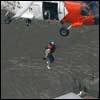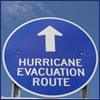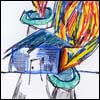Recognizing 10 years since Hurricane Katrina (Aug. 23-31, 2005)
Third in a series of articles on the storm, its aftermath and the ensuing growth of Chabad-Lubavitch of Louisiana
Ten years ago this month, Baton Rouge, La., was a primary destination for rescue workers and supplies dispatched in the aftermath of Hurricane Katrina from Lubavitch World Headquarters in the Crown Heights neighborhood of Brooklyn, N.Y. As many as 200,000 residents had fled the floods for the relative safety of the state’s capital and second largest city, about 80 miles to the northwest of New Orleans.
This week, a truck from Brooklyn came to Baton Rouge carrying a very different load: Hebrew books, Judaica supplies, and the personal belongings of Rabbi Peretz and Chaya Mushka Kazen, who will be founding the city’s first permanent Chabad House. They arrived on Monday with their baby daughter, Miriam, in tow.
“For the time being, our house will double as our Chabad center,” says the rabbi, who grew up in Brooklyn, “so moving into our home is essentially opening up our Chabad House as well.”
The Kazens—he is 26, and she is 23—visited the city for Purim and Passover. Each time, they distributed holiday supplies and got to know members of the local community.
In the weeks before their move, the couple directed Gan Israel Day Camp in New Orleans, which had scaled down considerably in the years following Katrina. This summer was the first time it reopened as a full camp experience for the wider Jewish community.
First High Holidays There

Baton Rouge sits on the eastern bank of the Mississippi river. It is the state’s capital and second-largest city after New Orleans, some 80 miles to the southeast.
The Kazens estimate that more than 1,100 local Jews reside there out of a total population of about 230,000, in addition to 250 Jewish students at Louisiana State University, where they will also serve as local Chabad on Campus representatives.
With just one month to Rosh Hashanah, the rabbi says he and his wife hope their home will be fully operational—and full of guests—in time for the holiday.
“People have been very welcoming,” he reports. “There is an upbeat positivity in the air about this great community and what the future will bring.”
The first article in the series “Ten Years After Hurricane Katrina: Two Rabbis Recall the Scene on the Ground” can be read here.
The second article in the series “Ten Years After Hurricane Katrina: Jewish New Orleans Keeps on Growing Younger” can be read here.
Next: Jewish life at Tulane University expands with second campus couple.










Join the Discussion